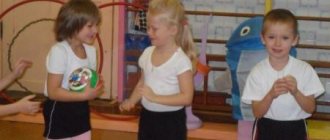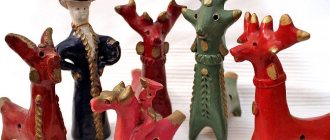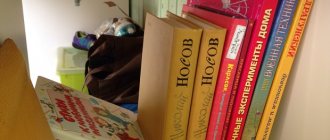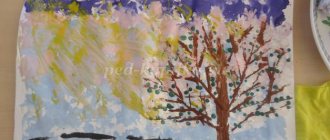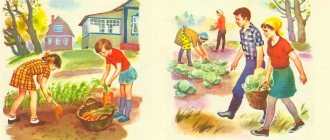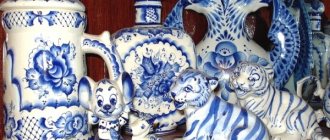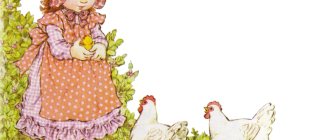MAGAZINE Preschooler.RF
Lesson 1 Topic: “Sensory education of children” Purpose: To teach children to compare objects by size (big-small, long-short), using the corresponding adjectives in speech. Strengthen the ability to distinguish and name colors: red, yellow, green. To promote the development of conversational communication during the lesson, to develop spatial orientation. Material: 2 nesting dolls (large and small), 2 houses (large and small), 2 Christmas trees (large and small), 2 baskets, 10 mushrooms (5 large and 5 small), a surprise box with two appearing ribbons (2 short and 2 long), 2 cockerels with colored feathers, box. Progress of the lesson: Children sit on chairs. In front of them are two nesting dolls on the table. Educator: “Children, two nesting dolls came to visit us. Lelya and Lyalya. Look, children, one of them is big - Lelya, and the other small is Lyalya. Our nesting dolls are different in size. This is a big one (ask the children which one?), and this is a small nesting doll (ask the children which one?).”Give instructions to reinforce the concepts of big and small: Ask them to repeat where the big doll is and where the small one is. Ask several children to find a large and a small nesting doll on the table and name “which one?” I continue the story: “The big matryoshka lived in a big house, and the little one in a small house.” Similarly, ask the children to name, find and show the big and small houses. “Near the big house there was a large Christmas tree, and near the small house there was a small Christmas tree.” Ask the children to repeat, find, name and show the big and small Christmas trees. “One day I wanted to go pick mushrooms for the nesting dolls. They took the baskets and went to the fairy forest. Children, let’s go with them.” Invite the children to first collect large mushrooms in a large basket, and then small ones in a small basket. In the forest, the teacher finds a surprise box. We look at the box together with the children, fix the color (red, yellow, green). Children pull ribbons out of the box, and the teacher explains - this ribbon is long, and this is short. Installation for consolidation: will invite several children to determine for themselves which ribbon the child pulled out (long - short) and name it. "Now, children, let's go home." Then the teacher listens and asks the children: “Children, who is screaming KOO-KA-RE-KU?” The children answer that it’s a cockerel. The teacher continues: “Once upon a time there were two cockerels, beautiful and elegant. One time they wanted to fly up the fence and crow. One cockerel flew up, but the second one fell and lost all its feathers. Let's guys help the rooster find his feathers." Children look for feathers around the group room. After all the feathers have been found, named by color and attached to the cockerel's tail, the teacher thanks the children and, on behalf of the cockerel, treats the children to peas - sweets from the box.
Lesson 2 Topic: “Sensory education of young children. Getting to know the shape of objects" Goal: To teach children to perform simple actions with objects. Draw their attention to the sensory characteristics of toys, causing an emotionally positive response. Reinforce the concepts: cube, brick, ball. Material: A bucket with a lid and small, easy-to-grab objects of different shapes and colors: Pyramid, cube, brick, mushroom, cylinder, egg, ball. Bear - toy, basket. Progress of the lesson: Children sit on chairs. The teacher says: “Children, Little Bear came to visit us today and brought us a magic bucket, and now we’ll find out what’s in it.” Then the teacher shows the children a bucket with a lid and explains that there is something in it. Remove the lid along with the Teddy Bear and show the objects in the bucket one by one and name them (put them back in the bucket). Then the teacher invites the child to put his hand in the bucket and take out some toy. The child takes out a cube or brick. The adult joyfully exclaims: “What a beautiful cube (brick), well done Nikita for taking it out of the bucket!” Praise, evoke an emotional response. The teacher continues: “This, children, is a cube.” Provide the opportunity to examine it, play with it, examine it with your hands, ask it to be repeated, as they say. Place it on the table and make sure it is stable. “The cube is a small house, and the brick (taken from the bucket) is the path to the house.” Ask the children to repeat the name “brick”, give them the opportunity to look and examine. “You can put two cubes on a brick; it is longer than a cube. The cube and the brick stand steadily on the table, but this object rolls around (get a ball, a testicle from time to time).” Give children the opportunity to examine, explore, and play. “This is a children’s ball, it’s round like a ball, and it stands unsteadily on the table and rolls around.” Then invite the children to take items out of the bucket one by one and name them. On tables, give the opportunity to play with them, put them on top of each other, roll round objects, learning in practice that they do not overlap, but they roll well. When all the items have been examined, examined and named, the Teddy Bear appears and tells the children that it’s time for him to go to the fairytale forest and asks the children to help him put all the toys in a bucket. The children diligently help Little Bear. For this, he thanks the children and offers to play the game “Bear in the Forest.” “I take mushrooms and berries from a bear in the forest, but the bear does not sleep and growls at us.” The fun game is repeated 2-3 times. The bear cub growls and cannot catch up with any of the children. Then the Little Bear tells the children that it’s time for him to go to the fairy forest and gives the children candy from the basket.
Teacher Shadrina Ekaterina Vladislavovna
| Next > |
Open lesson on sensory development in the senior group. Abstract
Summary of an open lesson on sensory development in the senior group on the topic: “Land of Games - Sensory”
Goal: enriching sensory experience, creating gaming conditions for the development of intellectual abilities. Objectives: - to cultivate emotional responsiveness, politeness, friendliness, and respectful attitude towards others; — develop motor activity, communication skills, interest in experimental activities (social-communicative, physical development); building self-confidence, strengthening the physical and mental health of children (physical development); - help develop his sensory capabilities: visual, tactile. - teach how to apply theoretical lessons in practice. Types of activities: gaming, motor, cognitive-research, social-communicative, productive. Equipment: multimedia projector, 2 easels, colorful balls, chest, colored mugs, colored pencils, sheets of white paper, bags of medicinal herbs, 2 jars (sugar, salt), presentation for the lesson.
Progress of the lesson
Educator: Hello my friends, I’m glad to see you all! Children: Do you want to say hello to the sun, the birds, etc. Children: Teacher: Good morning to the Sun and the birds! Good morning to smiling faces And everyone becomes kind and trusting Let the good morning last until the evening. -Do you like to play? Children: -Do you want to go with me to a wonderful country called “Land of Games - Sensorics!”? Children: Educator: -Do you know how to get to our extraordinary country? Children: -Before I set off, I want to show you something. (The teacher shows a large “chest of sensations”, music from the program “What? Where? When?” plays) Educator: - I suggest you find out by touch what is in the “chest of sensations”. (Those who wish, feel the chest and name what may lie in the chest). And to guess what is in the chest, we need to go on a plane trip. Educator: - Our plane is taking off! (The song “Airplane” from the collection - Children's Songs sounds) Educator: - Well, we landed at the first airport. Rainbow City Presentation “Colorful Country” (slide 2 - 15)
- Can you guess what the city is called?
Children: -Rainbow City. Educator: -And the residents of this city want to teach you how to play their games. “Balls” 1. Children need to collect balls into baskets at the same time with 2 hands, yellow in the right hand, blue in the left. Who will score more? 2. "Colored mugs." Pupils are invited to join the circle. The teacher has 4 mugs of different colors in his hands. When raising the red circle, all pupils must sit down, the yellow circle must jump, the green circle must walk in place, the blue circle must run in a circle one after another. The inhabitants of this country want to help us find out what is in the sensation chest and give us a hint (shows a green card), which means there is a green object in the chest, remember. — Thank you, residents, for showing interesting games that introduce color. And it's time for us to go. (Music sounds, the plane flies further).
— What is the name of this city, let’s guess?
(I’m asking riddles about geometric shapes, showing the presentation (slide 16-20)
1. Three vertices are visible here, Three angles, three sides, - Well, perhaps that’s enough! - What do you see? - Answer: Triangle 2. There are no angles me, And I look like a saucer, Like a plate and a lid, Like a ring, like a wheel. Who am I, friends? Answer: Circle 3. I’m neither an oval nor a circle, I’m a friend to the triangle, I’m a brother to the rectangle, After all, my name is Answer: Square 4. Trace the whole brick with chalk On the asphalt, And you will get a figure - You, of course, are familiar with it. Answer: Rectangle
(The teacher asks the last riddle)
And my brother, Seryozha, Mathematician and draftsman - On Baba Shura’s table Draws all sorts of things Answer: Figures
Educator: -Have you guessed the name of the city? Children: City of “Figures” Educator: -Well done! Game “Recognize and Count"
(slide 21 - 25)
Game “Artist”. Each child is asked to take 2 identical pencils and draw 2 hands at the same time any geometric figure... Then he offers to again, with both hands, complete the details on this figure to form an object. — Thanks to this game, we were able to find out that in the chest there is an object (shows the second and third cards) that is round in shape and small in size. Let's remember! And our plane is calling us forward again! (music sounds) Let's fly on! City of "Cooks". - Look who's meeting us? Children: (slide 26) Educator: - Chefs have a well-developed sense of smell and taste. Game “Taste” I offer the children 2 jars (sugar, salt). Assignment: “Let’s guess what taste?”: let’s try salty, sweet tastes. Game “Bags” I show the children bags with the smells of medicinal herbs. And I suggest that you smell the bag, determine what the bag is filled with and find an image of this filler in the picture (slide show 27-30) - The cook tells us that there is a sweet object in the “chest of sensations”. (shows a drawing at the presentation). Now it's time to guess. Guys, what is in our “chest of sensations”? -That's right, apple! - Well done!!! (The cook gives away all the apples).
We say goodbye to the cook and thank him for the treat.
Educator: Now it's time to go back to kindergarten. We sit down more comfortably and fly. Guys, our journey has come to an end. Reflection. Did you like it? What filled us more in our journey? Children:
We recommend watching:
Summary of educational activities in the senior group “Journey to a Fairy Tale” Summary of a mathematics lesson for children of the senior orthopedic group Summary of educational and gaming activities in the senior group in the section of the “Childhood” program Synopsis of educational activities for the perception of music in the senior group of kindergarten
Similar articles:
Lesson in the senior group of kindergarten on the topic of February 23
Lesson notes for children of senior preschool age. Topic: Invisible air
Summary of organized educational activities for children of the senior group
Notes for mathematics classes in the senior group
Lesson summary on the topic “Reserve” in the senior group
Progress of the lesson.
The teacher says to the children: “Remember, we saw the birds on our walk. How they jump, fly; How nimble and agile they are! And today I brought you this bird. Look how beautiful and bright she is. Today we will sculpt a bird with a little chick.
What does this bird have?” - "Taurus"
.
- “What shape is it?”
- "Round"
and long." - “Come here, Vanya, show the children what a long and round body the bird has (invites the child to run his hand over the body)
.
Well done. Who knows how we will sculpt it? Show everyone how we will sculpt the head. And what's that?" - "Beak"
.
- “That’s how sharp he is. Come, Misha, show the children how sharp the beak is. And you, Dasha, show me too. What else have we forgotten?” - "Tail"
.
- “That’s the kind of tail the bird has! Now we know how to sculpt a bird. The chick is sculpted in the same way as a bird, only it is small. Now everyone, take the clay in your hands, separate a small piece and set it aside. We will sculpt a chick from it. And also divide this large piece into two parts: a large one for the body, a small one for the head. Place the whole big piece on your hand and start sculpting the body.” Children also sculpt a head. The teacher reminds that then you need to stretch out the beak and tail. After the children make a bird, he offers to make a small chick. At the end of the lesson, the teacher notes : “What different, but beautiful birds the children made!”
Physical education minute.
The teacher tells the children let's play the game "Birds and Cars"
.
Children - “birds”
“fly”
around the group, waving their arms; like wings, and the teacher sings:
The birds have arrived, (Children - “birds”
“fly”
.)
The birds are small.
We flew, we flew,
They flapped their wings. ( "Birds"
jump on the bench and
So they flew, squatted on bent legs,
They flapped their wings. Then they jump to the floor and sit on
They flew onto the path, squatted, tapped their finger on the floor -
The grains were pecked. "peck"
.)
A teacher appears with a toy car in his hands, a horn sounds, and the car drives away. The teacher says or sings:
A car is running down the street (Children are “birds”
run away quickly
Puffing, hurrying, honking the horn. from the car and stand on
Tra-ta-ta, watch out, move aside! bench.)
theme: “Funny pictures”
Program content.
Teach children plane modeling. Develop the ability for visual analysis, form an idea of construction details, geometric shapes, develop visual memory , design thinking . Promote group activities, speech and play communication.
Progress of the lesson.
The teacher holds the Parsley doll in his hands and addresses the children:
“Hello, guys, I came to visit you and brought gifts, and what kind of gifts are they, try to guess:
What's missing, what's missing
In my flat box,
All earthly colors, lightning, sunrises
Stored under a lid in it"
If the children find it difficult to answer, Parsley opens a box of colored pencils and turns to the children: “Do you know what kind of colored sticks these are, what are they for?”
.
After the children answer, he takes a pencil and tries to draw with the unsharpened blunt end. The children tell Petrushka how to take a pencil correctly. The teacher invites two or three children to show Petrushka how to draw (they depict some object)
. Parsley looks attentively, then thanks the children for teaching him how to hold a pencil correctly and asks the children to draw him many, many beautiful round balls, large and small, with which he and his friends will play.
The children begin to draw. While drawing, Petrushka looks at what kind of balls it turns out. After the lesson , he praises the children for drawing so many round balls that he will use to play with his friends. Petrushka thanks the guys for teaching him how to paint with colors
topic: “Carrots large and small”
Tasks.
Teach children to compare by size, define: “big”
,
“small”
,
“more”
,
“even more”
,
“less”
; convey differences in size in the sculpting of these objects, their general shape.
Material. Prepare several carrots of different sizes, clay and all the accessories for modeling.
Progress of the lesson.
Educator: Look who came to our lesson . (Dolls)
.
This doll's name is Dasha. Is it big or small? Alice, tell me about the doll. What is she wearing? (As the story progresses, the teacher helps: “What is this?” (Shoes.) “What color are they?”
Etc.) Nino, show me the little doll.
Her name is Dina. What is she like? (Beautiful, elegant.)
What kind of hair does she have? What color is the dress?
— How do you play with dolls? (We dress, feed, put to bed, take for walks.)
- Now let someone tell you about the dolls (1 - 2 stories; the teacher helps the children with questions)
.
— The dolls Dasha and Dina played and went for a walk. Dasha took the balls with her. What kind of ball is this? (Small.)
What colour is he?
What are you doing with the ball? (We play football, catch, roll, throw.)
Who will tell you about the balls?
“The Dina doll also took two buckets for a walk: one... large, red, the other... small, blue. How can you play with a bucket? (Pour sand into it, add snow, pour water.)
Who wants to talk about buckets? This is... a bucket. It's... big, red. I pour sand, snow into a bucket.
- Well done, you told well how Dasha played... with balls, and Dina... with buckets.
Physical education minute.
The teacher suggests: “Let's play. All the guys will be balls. They will jump high, like a big ball.” Children pretend to be balls, then sit down in their places.
— Dasha played outside and came home. On her table lay... (shows a pipe)
.
What is this? (The pipe.)
Listen to how Dasha plays it. The pipe sings: doo-doo-doo. How does the pipe sing? What does Dasha play?
— Dean’s doll was found on the table... (shows a bell.)
The bell rings: ding-ding.
— Dasha plays the... (pipe)
. Dina rings... a bell, ding-ding.
- Vasya, play the pipe (doo-doo-doo, and you Ksenia, ring it like a bell (ding-ding-ding)
.
- Look at the toys I have on the table (pipe, bell, ball, bucket)
. Doll Dasha wants to play with you. She will hide the toy, and you will guess which toy is missing.
- Listen: pipe, bucket. These words contain the d sound.
theme: “Circle and square”
Tasks.
Teach children to find one or many objects in a specially created environment, to denote aggregates with the words one, many.
Introduce the square, teach to distinguish between a circle and a square.
Didactic visual material.
Demonstration material. "Package"
with toys
(cars, nesting dolls, pyramid, ball)
;
a square and a circle of the same color (the length of the sides of the square and the diameter of the circle are 14 cm)
.
Handout. Circles and squares of the same color (the length of the sides of the square and the diameter of the circle are 8 cm)
.
Progress of the lesson.
The teacher invites the children to make colorful trailers with windows and wheels. Shows how to use glue correctly, reminds you of the gluing sequence.
During the lesson, the teacher helps those who have difficulties by making clarifications on behalf of the toy characters.
Physical education minute.
The teacher offers the children. Let's play, shows the child a train or a picture, reminds how the locomotive whistles (pronounces the sound U in a drawn-out manner, and suggests repeating this sound in the same drawn-out and loud manner. The teacher makes sure that when playing the sound U, the child makes a “tube”
. At the end of the game, the child and the adult walk through the group like a train,” and the child loudly imitates the locomotive’s whistle. The teacher reads the poem:
The locomotive whistled
And he brought the trailers.
- Chok - chuk, chuk - chuk!
I'll rock you far - woohoo!
Topic: “For you, kids, colored pencils”
Tasks.
Teach children to depict the shape of a circle (a new task, create interest in children to draw with colored pencils, choose colors as they wish.
Material. Paper, pencils, Parsley, screen.
Preliminary work. Game with balls.
Progress of the lesson.
Parsley (doll)
brings the children a box with a surprise. Kids open it and take out envelopes that depict colored plot appliqués from geometric shapes, inside the envelope there are cards with objects from which the plot is created, and cut out figures. The images are given in different ways: in the form of appliqués, outlines (drawn with felt-tip pens of different colors, cut out holes Cards are made of cardboard, oilcloth, thick transparent film and other materials.
A subgroup of 3-4 people is given an envelope with a manual and everyone is asked to put a picture on the table, like the one on the envelope.
The teacher groups the children according to their abilities, giving some the task easier, others more difficult. It should be noted that the task is all the more difficult. The more details required to recreate the image and the more varied these details are.
During the activity, the teacher provides active assistance to the children, asks some children to name the details, their color, and practices naming the spatial arrangement of the parts: “Where is the sun? - At the top. -Where is the house? - At the bottom. “The cat is on the right, what’s in the middle?”
After finishing their work, the children show their pictures to Parsley and tell him what they depicted.
Game tasks
Compose pictures using the aids suggested above. Complicating tasks, for example, laying out pictures of geometric shapes and building parts by eye using a reduced image (i.e., without overlapping)
.
Design according to the plan , themes, close to children's ideas ( “Animals are resting in the country”
,
“Merry little men are traveling by train”
,
“We are relaxing at sea”
,
“Fairy-tale houses in the forest”,
etc.).
Individual and collective construction from various building kits and elementary construction sets .
topic: “Description of dolls”
Tasks. Learn to correctly name objects, their qualities, actions; compare objects by size using the adjectives big, small; agree nouns with adjectives in gender;
sound culture of speech:
Strengthen the pronunciation of sounds.
Material.
Pairs of objects: dolls (large and small, balls (large and small, different colors), two buckets (different sizes and colors)
; pipe, bell.
